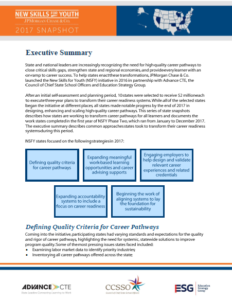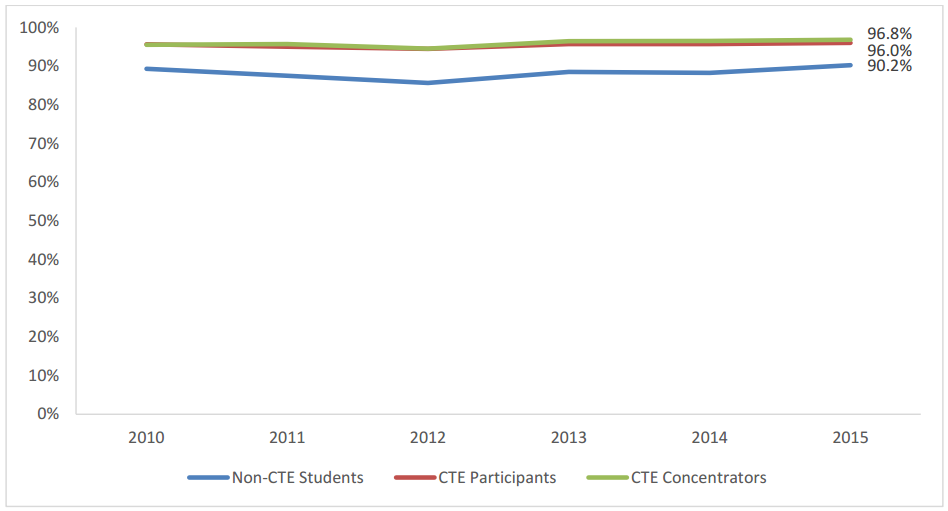 Throughout history, and continuing today, learners of color, low-income learners, female learners and learners with disabilities have been historically tracked into terminal vocational programs leading to jobs with uncertain promise of economic growth and prosperity. To help state leaders recognize these historical barriers and adopt promising solutions to close equity gaps in CTE, Advance CTE launched a series of policy briefs titled Making Good on the Promise. The first briefs in the series explored the history of inequities in CTE and highlighted promising practices from states that are using data to identify and address access and achievement gaps by different learner populations.
Throughout history, and continuing today, learners of color, low-income learners, female learners and learners with disabilities have been historically tracked into terminal vocational programs leading to jobs with uncertain promise of economic growth and prosperity. To help state leaders recognize these historical barriers and adopt promising solutions to close equity gaps in CTE, Advance CTE launched a series of policy briefs titled Making Good on the Promise. The first briefs in the series explored the history of inequities in CTE and highlighted promising practices from states that are using data to identify and address access and achievement gaps by different learner populations.
Building off these briefs, the third brief in the series, Making Good on the Promise: Building Trust to Promote Equity in CTE, maps out steps state leaders can take to rebuild trust in marginalized communities that CTE historically failed to serve equitably. The brief outlines five steps state leaders can take to build trust in communities that do not view CTE as a viable mechanism to help them achieve their college and career goals:
- Acknowledge that inequity is a problem;
- Promote a culture that values equity and diversity within the state agency and instructor workforce;
- Commit to transparency and advancing only high-quality CTE programs of study;
- Implement strategies to gain buy-in from communities and stakeholders; and
- Celebrate, lift up and replicate successful programs of study and practices.
To helps states with these steps, the brief features state examples from Oklahoma, Wisconsin, Massachusetts, Idaho and Nebraska and draws on messaging data from Advance CTE’s The Value and Promise of Career Technical Education: Results from a National Survey of Parents and Students:
- In Oklahoma, the Department of Career and Technology Education created an equity and diversity specialist position in 2016 to provide diversity training to agency staff, teachers and administrators to promote equity through the secondary and postsecondary systems.
- In Wisconsin, the Wisconsin Technical College System (WTCS) formed the Diversity, Equity and Inclusion Work Group to promote equity in WTCS.
Brianna McCain, Policy Associate


 The points an institution receives in the formula for credential attainment are multiplied if the credentials are in Science, Technology, Engineering and Mathematics (STEM) or state-defined “high-demand” fields. Qualifying fields are designated by the the Arkansas Department of Higher Education and the Department of Workforce Services. The multiplier for STEM degrees is 3 points; the multiplier for degrees in high-demand fields is 1.5 points.
The points an institution receives in the formula for credential attainment are multiplied if the credentials are in Science, Technology, Engineering and Mathematics (STEM) or state-defined “high-demand” fields. Qualifying fields are designated by the the Arkansas Department of Higher Education and the Department of Workforce Services. The multiplier for STEM degrees is 3 points; the multiplier for degrees in high-demand fields is 1.5 points.  What defines a high-quality career pathway? Is it alignment to labor market needs and career opportunities? The quality and qualifications of teachers and faculty? Access to meaningful, aligned work-based learning experiences? Perhaps all of the above?
What defines a high-quality career pathway? Is it alignment to labor market needs and career opportunities? The quality and qualifications of teachers and faculty? Access to meaningful, aligned work-based learning experiences? Perhaps all of the above? 
 The Public Policy Forum, a research organization based out of Milwaukee, recently published a
The Public Policy Forum, a research organization based out of Milwaukee, recently published a  The study finds that, within the population of students that did not go on to a four-year degree, CTE students were 11 percent more likely to “achieve” than non-CTE students. According to the study, “achievement” is measured as persistence in apprenticeship programs, persistence in community and technical colleges, employment and certificate attainment. Additionally, CTE programs accommodated a higher proportion of students receiving free and reduced price lunch and students with disabilities than other non-CTE programs, indicating that CTE could be a strategy for students of all socioeconomic backgrounds and abilities to acquire the skills needed for high-demand, high-wage careers.
The study finds that, within the population of students that did not go on to a four-year degree, CTE students were 11 percent more likely to “achieve” than non-CTE students. According to the study, “achievement” is measured as persistence in apprenticeship programs, persistence in community and technical colleges, employment and certificate attainment. Additionally, CTE programs accommodated a higher proportion of students receiving free and reduced price lunch and students with disabilities than other non-CTE programs, indicating that CTE could be a strategy for students of all socioeconomic backgrounds and abilities to acquire the skills needed for high-demand, high-wage careers. 
